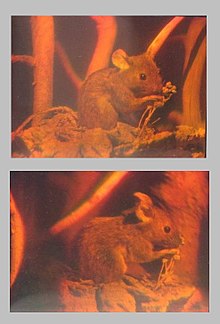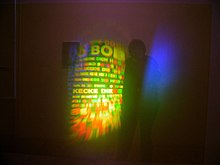
نص أفقي متماثل ، بواسطة ديتر جونغ

صورتان لهولوغرام واحد مأخوذة من وجهات نظر مختلفة
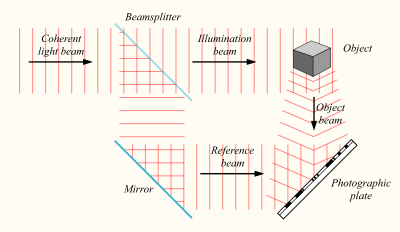
تسجيل صورة ثلاثية الأبعاد
الهولوغرافي – Holography
من ويكيبيديا
الهولوغرافي هو علم وممارسة صنع الصور المجسمة. الهولوغرام هو تسجيل العالم الحقيقي لنمط التداخل الذي يستخدم الانحراف لإعادة إنتاج ثلاثي الأبعاد مجال الضوء، مما يؤدي إلى صورة لا تزال في العمق ، المنظر، وغيرها من خصائص المشهد الأصلي.[1] الهولوغرام هو تسجيل فوتوغرافي لحقل ضوئي ، وليس ملف صورة شكلتها أ عدسة. عادةً ما يكون الوسيط الهولوغرافي ، على سبيل المثا
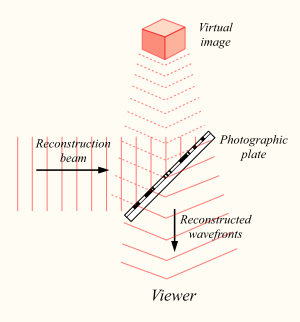
إعادة بناء صورة ثلاثية الأبعاد
ل الكائن الذي تم إنتاجه بواسطة عملية الهولوغرام (والتي قد يشار إليها باسم الهولوغرام) غير مفهوم عند مشاهدته تحت منتشر للضوء المحيط. إنه ترميز لحقل الضوء كملف التشوش نمط الاختلافات في العتامة, كثافة، أو المظهر الجانبي لوسط التصوير الفوتوغرافي. عندما تكون مضاءة بشكل مناسب ، فإن نمط التداخل حيود الضوء في استنساخ دقيق لمجال الضوء الأصلي ، والأشياء التي كانت فيه تظهر بصرية منبهات العمق مثل المنظر و إنطباع التي تتغير بشكل واقعي مع زوايا المشاهدة المختلفة. أي أن عرض الصورة من زوايا مختلفة يمثل الموضوع الذي يُنظر إليه من زوايا مماثلة. وبهذا المعنى ، لا تحتوي الصور المجسمة على وهم العمق فحسب ، بل هي في الحقيقة صور ثلاثية الأبعاد.
في شكله النقي ، يحتاج التصوير المجسم إلى أ الليزر ضوء لإضاءة الموضوع ولعرض الصورة المجسمة النهائية. أ مجهري يمكن إعادة إنتاج مستوى التفاصيل في جميع أنحاء المشهد المسجل. ومع ذلك ، في الممارسة الشائعة ، يتم إجراء تنازلات كبيرة في جودة الصورة لإزالة الحاجة إلى إضاءة الليزر لعرض الهولوغرام ، وفي بعض الحالات ، لجعلها. غالبًا ما تلجأ البورتريه المجسم إلى إجراء التصوير الوسيط غير المجسم ، لتجنب الخطورة العالية القوة ليزر نابض والتي ستكون ضرورية “لتجميد” الأهداف المتحركة بصريًا تمامًا كما تتطلب عملية التسجيل الهولوغرافي الشديدة الحساسية للحركة. يمكن الآن أيضًا إنشاء الصور المجسمة بالكامل بواسطة الكمبيوتر لإظهار الأشياء أو المشاهد التي لم تكن موجودة من قبل.
التصوير المجسم يختلف عن عدسي وغيرها في وقت سابق تنظير ذاتي تقنيات العرض ثلاثية الأبعاد ، والتي يمكن أن تنتج نتائج متشابهة ظاهريًا ولكنها تعتمد على التصوير التقليدي للعدسة. الصور تتطلب مساعدة نظارات خاصة أو بصريات وسيطة أخرى، أوهام المرحلة مثل شبح الفلفل وغيرها من الصور غير العادية أو المحيرة أو التي تبدو سحرية غالبًا ما يطلق عليها بشكل غير صحيح الصور المجسمة.
دينيس جابور اخترع التصوير المجسم في عام 1947 وفاز لاحقًا
بجائزة نوبل لجهوده.
ال المجرية-بريطاني فيزيائي دينيس جابور (في الهنغارية: غابور دينس)[2][3] حصل على جائزة نوبل في الفيزياء في عام 1971 “لاختراعه وتطوير طريقة التصوير المجسم”.[4]تم إنجاز عمله في أواخر الأربعينيات من القرن الماضي ، وقد بُني على عمل رائد في مجال الفحص المجهري بالأشعة السينية من قبل علماء آخرين بما في ذلك Mieczysław Wolfke في عام 1920 و وليام لورانس براج في عام 1939.[5] كان هذا الاكتشاف نتيجة غير متوقعة للبحث في التحسين المجاهر الإلكترونية في ال طومسون البريطانية هيوستن شركة (BTH) في كرة القدم الامريكية، إنجلترا ، وقدمت الشركة براءة اختراع في ديسمبر 1947 (براءة اختراع GB685286). التقنية كما تم اختراعها في الأصل لا تزال تستخدم في المجهر الإلكتروني، حيث يُعرف باسم الهولوغرافي الإلكترون، لكن التصوير المجسم البصري لم يتقدم حقًا حتى تطور الليزر عام 1960. كلمة الهولوغرافي يأتي من اليونانية كلمات ὅλος (هولوس؛ “كله”) و αφή (الرسم البيانيē; “جاري الكتابة”أو”رسم”).
تطوير الليزر مكّن من صنع أول صور ثلاثية الأبعاد عملية بصرية سجلت كائنات ثلاثية الأبعاد في عام 1962 يوري دينيسيوك في الاتحاد السوفيتي[6] وبواسطة ايميت ليث و جوريس Upatnieks في ال جامعة ميشيغان، الولايات المتحدة الأمريكية.[7] تم استخدام الصور المجسمة المبكرة هاليد الفضة المستحلبات الفوتوغرافية كوسيط التسجيل. لم تكن فعالة للغاية حيث امتص المشبك الناتج الكثير من الضوء الساقط. تم تطوير طرق مختلفة لتحويل التباين في الإرسال إلى اختلاف في معامل الانكسار (المعروف باسم “التبييض”) مما أتاح إنتاج صور ثلاثية الأبعاد أكثر كفاءة.[8][9][10]
يمكن عمل عدة أنواع من الصور المجسمة. يتم عرض الصور المجسمة للإرسال ، مثل تلك التي تم إنتاجها بواسطة Leith و Upatnieks ، من خلال تسليط ضوء الليزر من خلالها والنظر إلى الصورة المعاد بناؤها من جانب الصورة المجسمة المقابلة للمصدر.[11] صقل لاحق ، صورة ثلاثية الأبعاد “انتقال قوس قزح”، يسمح بإضاءة أكثر ملاءمة بالضوء الأبيض بدلاً من الليزر.[12] تُستخدم الصور المجسمة بألوان قوس قزح بشكل شائع للأمان والمصادقة ، على سبيل المثال ، على بطاقات الائتمان وتغليف المنتج.[13]
هناك نوع آخر من الصور المجسمة الشائعة ، وهو انعكاس أو Denisyuk الهولوغرام ، يمكن أيضًا مشاهدته باستخدام مصدر إضاءة أبيض اللون على نفس الجانب من الصورة المجسمة مثل العارض وهو نوع الهولوغرام الذي يُرى عادةً في العروض الثلاثية الأبعاد. كما أنها قادرة على إعادة إنتاج الصور متعددة الألوان.[14]
التصوير المجسم هي تقنية ذات صلة لعمل صور ثلاثية الأبعاد من خلال التحكم في حركة الانعكاسات على سطح ثنائي الأبعاد.[15] إنه يعمل عن طريق التلاعب الانعكاسي أو الانكساري بحزم أشعة الضوء ، في حين يعمل التصوير الهولوغرافي بأسلوب غابور عن طريق إعادة بناء واجهات الموجة بشكل انعكاسي.
معظم الصور المجسمة التي تم إنتاجها هي لأجسام ثابتة ولكنها أنظمة لعرض مشاهد متغيرة على صورة ثلاثية الأبعاد العرض الحجمي يتم تطويرها الآن.[16][17][18]
يمكن أيضًا استخدام الصور المجسمة لتخزين المعلومات واستردادها ومعالجتها بصريًا.[19]
في أيامها الأولى ، تطلب التصوير المجسم ليزرًا عالي الطاقة وباهظ الثمن ، ولكنه حاليًا منخفض التكلفة. ثنائيات الليزر، مثل تلك الموجودة في مسجلات DVD واستخدامها في التطبيقات الشائعة الأخرى ، يمكن استخدامها لإنشاء الصور المجسمة وجعل الهولوغرافي أكثر سهولة للباحثين ذوي الميزانية المحدودة والفنانين والهواة المتفانين.
كان يُعتقد أنه سيكون من الممكن استخدام الأشعة السينية لعمل صور ثلاثية الأبعاد لأجسام صغيرة جدًا وعرضها باستخدام الضوء المرئي.[بحاجة لمصدر] اليوم ، يتم إنشاء الصور المجسمة مع الأشعة السينية باستخدام السنكروترونات أو الأشعة السينية ليزر الإلكترون الحر كمصادر إشعاعية وكاشفات منقطة مثل أجهزة المتقارنة بواسطة الشحنات كوسيلة تسجيل.[20] ثم يتم استرداد إعادة الإعمار عن طريق الحساب. بسبب الطول الموجي الأقصر لـ الأشعة السينية مقارنةً بالضوء المرئي ، يسمح هذا الأسلوب بتصوير الأجسام بدقة مكانية أعلى.[21] مثل ليزر الإلكترون الحر يمكن أن توفر نبضات فائقة القصر والأشعة السينية في نطاق فيمتوثانية وهي مكثفة ومتماسكة ، وقد تم استخدام التصوير المجسم بالأشعة السينية لالتقاط عمليات ديناميكية فائقة السرعة.[22][23][24]
كيف تعمل:
التصوير المجسم هو تقنية تمكن من تسجيل مجال الضوء (والذي يكون بشكل عام نتيجة لمصدر الضوء المتناثرة من الكائنات) ليتم إعادة بنائه لاحقًا عندما لا يكون مجال الضوء الأصلي موجودًا ، بسبب عدم وجود الكائنات الأصلية.[25] يمكن اعتبار التصوير المجسم مشابهًا إلى حد ما لـ تسجيل الصوت، حيث يتم إنشاء مجال صوتي عن طريق اهتزاز مادة مثل الات موسيقية أو الأحبال الصوتية، يتم ترميزها بطريقة يمكن إعادة إنتاجها لاحقًا ، دون وجود المادة الاهتزازية الأصلية. ومع ذلك ، فهو أكثر شبهاً بـ أمبيسونيك تسجيل صوتي يمكن فيه إعادة إنتاج أي زاوية استماع لمجال صوتي في عملية الاستنساخ.
الليزر
في التصوير المجسم بالليزر ، يتم تسجيل الهولوغرام باستخدام مصدر الليزر الضوء ، وهو نقي جدًا في لونه ومنظم في تكوينه. يمكن استخدام إعدادات مختلفة ، ويمكن عمل عدة أنواع من الصور المجسمة ، ولكن جميعها تتضمن تفاعل الضوء القادم من اتجاهات مختلفة وإنتاج نمط تداخل مجهري طبقأو فيلم أو وسيلة أخرى فوتوغرافيا السجلات.
في ترتيب واحد مشترك ، يتم تقسيم شعاع الليزر إلى قسمين ، أحدهما يعرف باسم شعاع الكائن والآخر مثل شعاع مرجعي. يتم توسيع شعاع الكائن عن طريق تمريره من خلال عدسة واستخدامه لإلقاء الضوء على الموضوع. يقع وسيط التسجيل حيث سيضربه هذا الضوء ، بعد أن ينعكس أو يتشتت بواسطة الموضوع. ستعمل حواف الوسيط في النهاية كنافذة يمكن من خلالها رؤية الموضوع ، لذلك يتم اختيار موقعه مع وضع ذلك في الاعتبار. يتم توسيع الحزمة المرجعية وجعلها تتألق مباشرة على الوسط ، حيث تتفاعل مع الضوء القادم من الموضوع لإنشاء نمط التداخل المطلوب.
مثل التصوير الفوتوغرافي التقليدي ، يتطلب التصوير المجسم صورة مناسبة التعرض الوقت للتأثير بشكل صحيح على وسط التسجيل. على عكس التصوير التقليدي ، أثناء التعريض الضوئي ، يجب أن يظل مصدر الضوء والعناصر البصرية ووسيط التسجيل والموضوع بلا حراك بالنسبة لبعضها البعض ، في حدود ربع الطول الموجي للضوء تقريبًا ، أو سيكون نمط التداخل غير واضح وأفسد الهولوغرام. مع الكائنات الحية وبعض المواد غير المستقرة ، يكون ذلك ممكنًا فقط إذا تم استخدام نبضة شديدة للغاية وقصيرة للغاية من ضوء الليزر ، وهو إجراء خطير نادر ونادرًا ما يتم إجراؤه خارج إعدادات المختبرات العلمية والصناعية. تعتبر التعريضات التي تستمر من عدة ثوان إلى عدة دقائق ، باستخدام ليزر يعمل باستمرار منخفضة الطاقة ، نموذجية.
جهاز:
يمكن عمل صورة ثلاثية الأبعاد عن طريق تسليط جزء من شعاع الضوء مباشرة في وسط التسجيل ، والجزء الآخر على الكائن بطريقة تسقط بعض الضوء المتناثر على وسيط التسجيل. يتطلب الترتيب الأكثر مرونة لتسجيل صورة ثلاثية الأبعاد أن يتم توجيه شعاع الليزر عبر سلسلة من العناصر التي تغيرها بطرق مختلفة. العنصر الأول هو فاصل الاشعة الذي يقسم الشعاع إلى حزمتين متطابقتين ، كل منهما يستهدف اتجاهات مختلفة:
ينتشر شعاع واحد (يُعرف باسم "الإضاءة" أو "شعاع الكائن") باستخدام العدسات وتوجيهها إلى المشهد باستخدام المرايا. بعض الضوء المنتشر (المنعكس) من المشهد ثم يسقط على وسط التسجيل.
الشعاع الثاني (المعروف باسم "الحزمة المرجعية") ينتشر أيضًا من خلال استخدام العدسات ، ولكن يتم توجيهه بحيث لا يتلامس مع المشهد ، وبدلاً من ذلك ينتقل مباشرة إلى وسيط التسجيل.يمكن استخدام العديد من المواد المختلفة كوسيط التسجيل. أحد أكثر الأفلام شيوعًا هو فيلم مشابه جدًا لـ فيلم فوتوغرافي (هاليد الفضة مستحلب فوتوغرافي) ، ولكن مع تركيز أعلى بكثير من الحبوب المتفاعلة مع الضوء ، مما يجعلها قادرة على أعلى من ذلك بكثير الدقة التي تتطلبها الصور المجسمة. يتم توصيل طبقة من وسيط التسجيل هذا (على سبيل المثال ، هاليد الفضة) بركيزة شفافة ، والتي تكون عادةً زجاجية ، ولكنها قد تكون أيضًا بلاستيكية.
معالجة
عندما تصل شعاعي الليزر إلى وسيط التسجيل ، تتقاطع موجات الضوء الخاصة بهما مع تدخل مع بعض. يتم طباعة نمط التداخل هذا على وسيط التسجيل. يبدو النمط نفسه عشوائيًا ، لأنه يمثل الطريقة التي يتم بها ضوء المشهد تدخلت مع مصدر الضوء الأصلي – ولكن ليس مصدر الضوء الأصلي نفسه. يمكن اعتبار نمط التداخل مشفر نسخة من المشهد تتطلب مفتاحًا معينًا – مصدر الضوء الأصلي – لعرض محتوياته.
يتم توفير هذا المفتاح المفقود لاحقًا عن طريق تسليط ليزر مطابق لتلك المستخدمة في تسجيل الهولوغرام على الفيلم المطور. عندما يضيء هذا الشعاع الصورة المجسمة ، يكون كذلك تحيد حسب نمط سطح الهولوغرام. ينتج عن هذا مجال ضوئي مطابق للحقل الذي أنتجه المشهد في الأصل وينتشر على الهولوغرام.
مقارنة مع التصوير الفوتوغرافي
يمكن فهم التصوير المجسم بشكل أفضل من خلال فحص اختلافاته عن العادي التصوير:
تمثل الصورة العاكسة ثلاثية الأبعاد تسجيلًا للمعلومات المتعلقة بالضوء الذي جاء من المشهد الأصلي كما هو مبعثر في مجموعة من الاتجاهات وليس من اتجاه واحد فقط ، كما في الصورة. يتيح ذلك عرض المشهد من مجموعة من الزوايا المختلفة ، كما لو كان لا يزال موجودًا.
يمكن تسجيل صورة فوتوغرافية باستخدام مصادر الضوء العادية (ضوء الشمس أو الإضاءة الكهربائية) في حين أن الليزر مطلوب لتسجيل صورة ثلاثية الأبعاد.
مطلوب عدسة في التصوير الفوتوغرافي لتسجيل الصورة ، بينما في التصوير المجسم ، ينتشر الضوء من الكائن مباشرة على وسط التسجيل.
يتطلب التسجيل الهولوغرافي شعاع ضوء ثانٍ (الحزمة المرجعية) ليتم توجيهه إلى وسط التسجيل.
يمكن مشاهدة الصورة في مجموعة واسعة من ظروف الإضاءة ، بينما لا يمكن مشاهدة الصور المجسمة إلا بأشكال محددة جدًا من الإضاءة.
عند تقطيع الصورة إلى النصف ، تظهر كل قطعة نصف المشهد. عندما يتم قطع صورة ثلاثية الأبعاد إلى النصف ، فلا يزال من الممكن رؤية المشهد بأكمله في كل قطعة. هذا لأنه ، في حين أن كل نقطة في تصوير يمثل فقط الضوء المنتشر من نقطة واحدة في المشهد ، كل نقطة على تسجيل ثلاثي الأبعاد يتضمن معلومات حول الضوء المنتشر من كل نقطة في المشهد. يمكن اعتباره بمثابة عرض لشارع خارج المنزل من خلال نافذة 120 سم × 120 سم (4 قدم × 4 قدم) ، ثم من خلال نافذة 60 سم × 120 سم (2 قدم × 4 قدم). يمكن للمرء أن يرى كل الأشياء نفسها من خلال النافذة الأصغر (بتحريك الرأس لتغيير زاوية الرؤية) ، ولكن يمكن للمشاهد رؤية المزيد ذات مرة من خلال نافذة 120 سم (4 قدم).
الصورة عبارة عن تمثيل ثنائي الأبعاد يمكنه فقط إعادة إنتاج تأثير بدائي ثلاثي الأبعاد ، بينما يضيف نطاق العرض المُعاد إنتاجه للصورة ثلاثية الأبعاد المزيد منبهات إدراك العمق التي كانت موجودة في المشهد الأصلي. يتم التعرف على هذه الإشارات من قبل العقل البشري وترجمت إلى نفس التصور لصورة ثلاثية الأبعاد كما لو تم عرض المشهد الأصلي.
تصور الصورة بوضوح مجال الضوء للمشهد الأصلي. يتكون سطح الصورة المجسمة المطورة من نمط دقيق للغاية يبدو عشوائيًا ، والذي يبدو أنه لا علاقة له بالمشهد الذي سجله.فيزياء التصوير المجسم
من أجل فهم أفضل للعملية ، من الضروري فهمها التشوش و الانحراف. يحدث التداخل عند واحد أو أكثر الجبهات الموجية متراكبة. الانحراف يحدث عندما تواجه واجهة الموجة كائنًا. يتم شرح عملية إنتاج إعادة البناء الثلاثية الأبعاد أدناه بحتة من حيث التداخل والانعراج. إنه مبسط نوعًا ما ولكنه دقيق بما يكفي لإعطاء فهم لكيفية عمل العملية الثلاثية الأبعاد.
بالنسبة لأولئك الذين ليسوا على دراية بهذه المفاهيم ، من المفيد قراءة هذه المقالات قبل قراءة المزيد في هذه المقالة.
واجهات موجة الطائرة
أ محزوز الحيود هي بنية ذات نمط متكرر. مثال بسيط هو صفيحة معدنية مقطوعة بشقوق على فترات منتظمة. تنقسم الموجة الضوئية التي تقع على محزوز إلى عدة موجات ؛ يتم تحديد اتجاه هذه الموجات المنعرجة من خلال تباعد الشبكة وطول موجة الضوء.
يمكن عمل صورة ثلاثية الأبعاد بسيطة عن طريق تركيب اثنين موجات الطائرة من نفس مصدر الضوء على وسيط تسجيل ثلاثي الأبعاد. تتداخل الموجتان ، مما يعطي a نمط هامش خط مستقيم التي تختلف شدتها جيبيًا عبر الوسط. يتم تحديد التباعد في نمط الهامش بالزاوية بين الموجتين وطول موجة الضوء.
نمط الضوء المسجل هو محزوز الحيود. عندما تضيء بموجة واحدة فقط من الموجات المستخدمة في إنشائها ، يمكن إثبات أن إحدى الموجات المنعرجة تظهر في نفس الزاوية التي وقعت فيها الموجة الثانية في الأصل ، بحيث تم “ إعادة بناء الموجة الثانية ” “. وبالتالي ، فإن نمط الضوء المسجل هو تسجيل ثلاثي الأبعاد على النحو المحدد أعلاه.
مصادر نقطة:
إذا كان وسط التسجيل مضاءً بمصدر نقطي وموجة مستوية عابرة ، فإن النمط الناتج يكون a لوحة المنطقة الجيبية، الذي يعمل بمثابة سلبي عدسة فريسنل طولها البؤري يساوي الفصل بين مصدر النقطة ومستوى التسجيل.
عندما تضيء مقدمة موجة مستوية عدسة سالبة ، يتم توسيعها إلى موجة تبدو متباعدة عن النقطة المحورية للعدسة. وهكذا ، عندما يضيء النمط المسجل بالموجة المستوية الأصلية ، فإن بعض الضوء ينحرف إلى شعاع متباين مكافئ للموجة الكروية الأصلية ؛ تم إنشاء تسجيل ثلاثي الأبعاد لمصدر النقطة.
عندما تسقط الموجة المستوية بزاوية غير عادية في وقت التسجيل ، يكون النمط المتكون أكثر تعقيدًا ، لكنه لا يزال يعمل كعدسة سالبة إذا كانت مضاءة بالزاوية الأصلية.
كائنات معقدة
لتسجيل صورة ثلاثية الأبعاد لجسم معقد ، يتم أولاً تقسيم شعاع الليزر إلى حزمتين من الضوء. يضيء شعاع واحد الكائن ، ثم ينثر الضوء على وسيط التسجيل. بالنسبة الى الانحراف من الناحية النظرية ، تعمل كل نقطة في الكائن كمصدر نقطة للضوء بحيث يمكن اعتبار وسيط التسجيل مضاءً بمجموعة من مصادر النقاط الموجودة على مسافات متفاوتة من الوسط.
تضيء الحزمة (المرجعية) الثانية وسيط التسجيل مباشرة. تتداخل كل موجة مصدر نقطية مع الحزمة المرجعية ، مما يؤدي إلى ظهور لوحة المنطقة الجيبية الخاصة بها في وسط التسجيل. النمط الناتج هو مجموع كل “لوحات المنطقة” هذه ، والتي تتحد لإنتاج عشوائي (رقطة) النمط كما في الصورة أعلاه.
عندما تضيء الصورة العاكسة ثلاثية الأبعاد بالحزمة المرجعية الأصلية ، تعيد كل من لوحات المنطقة الفردية بناء موجة الكائن التي أنتجتها ، ويتم دمج واجهات الموجة الفردية هذه لإعادة بناء حزمة الكائن بالكامل. يرى العارض واجهة موجة متطابقة مع واجهة الموجة المنتشرة من الكائن على وسيط التسجيل ، بحيث يبدو أن الكائن لا يزال في مكانه حتى إذا تمت إزالته.
نموذج رياضي
يمكن نمذجة الموجة الضوئية أحادية التردد بواسطة a عدد مركب, يو، والذي يمثل كهربائي أو حقل مغناطيسي من موجة ضوئية. ال السعة و مرحلة من الضوء يمثله قيمه مطلقه و زاوية من العدد المركب. يتم إعطاء الكائن والموجات المرجعية في أي نقطة في النظام الهولوغرافي بواسطة يوا و يوص. يتم إعطاء الحزمة المدمجة بواسطة يوا + يوص. تتناسب طاقة الحزم المدمجة مع مربع حجم الموجات المجمعة مثل
إذا تم تعريض لوحة فوتوغرافية للحزمتين ثم تم تطويرها ، فإن نفاذيةها ، تي، يتناسب مع الطاقة الضوئية التي وقعت على اللوح وتعطى بواسطة
أين ك ثابت.
عندما تضيء اللوحة المطورة بواسطة الحزمة المرجعية ، ينتقل الضوء عبر اللوحة ، يوح، يساوي النفاذية ، تي، مضروبة في سعة الحزمة المرجعية ، يوص، إعطاء
ويمكن أن نرى أن يوح أربعة مصطلحات ، يمثل كل منها شعاعًا ضوئيًا يخرج من الصورة ثلاثية الأبعاد أولها يتناسب مع يوا. هذا هو شعاع الكائن المعاد بناؤه ، والذي يمكّن المشاهد من “رؤية” الكائن الأصلي حتى عندما لم يعد موجودًا في مجال الرؤية.
الحزمان الثاني والثالث عبارة عن نسخ معدلة من الحزمة المرجعية. المصطلح الرابع هو “شعاع الكائن المترافق”. لها انحناء عكسي لحزمة الكائن نفسها وتشكل a الصورة الحقيقية للكائن في الفضاء خارج اللوحة الثلاثية الأبعاد.
عندما يتم عرض حزم الإشارة والكائن على وسيط التسجيل المجسم بزوايا مختلفة بشكل كبير ، تظهر جميع واجهات الموجة الافتراضية والحقيقية والمرجعية بزوايا مختلفة ، مما يتيح رؤية الكائن المعاد بناؤه بوضوح.
تسجيل صورة ثلاثية الأبعاد
العناصر المطلوبة: لعمل صورة ثلاثية الأبعاد ، يلزم ما يلي:
لعمل صورة ثلاثية الأبعاد ، يلزم ما يلي:
- كائن مناسب أو مجموعة من الأشياء
- يتم توجيه جزء من شعاع الليزر بحيث يضيء الكائن (شعاع الكائن) وجزء آخر بحيث يضيء وسيط التسجيل مباشرة (الحزمة المرجعية) ، مما يتيح للشعاع المرجعي والضوء المنتشر من الكائن على وسيط التسجيل لتشكيل نمط تداخل
- وسيط تسجيل يحول نمط التداخل هذا إلى عنصر بصري يعدل إما سعة أو طور حزمة الضوء الساقط وفقًا لشدة مخطط التداخل.
- شعاع الليزر الذي ينتج متماسك ضوء واحد الطول الموجي.
- بيئة توفر استقرارًا ميكانيكيًا وحراريًا كافيًا بحيث يكون نمط التداخل مستقرًا خلال الوقت الذي يتم فيه تسجيل نمط التداخل[26]
هذه المتطلبات مترابطة ، ومن الضروري فهم طبيعة التداخل البصري لرؤية ذلك. التشوش هو الاختلاف في الشدة والتي يمكن أن تحدث عند اثنين موجات الضوء متراكبة. تتجاوز شدة الحد الأقصى مجموع الشدة الفردية للحزمتين ، والشدة عند الحد الأدنى أقل من هذا وقد تكون صفرًا. يرسم مخطط التداخل المرحلة النسبية بين الموجتين ، وأي تغيير في الأطوار النسبية يتسبب في تحرك نمط التداخل عبر مجال الرؤية. إذا تغيرت المرحلة النسبية للموجتين بدورة واحدة ، فإن النمط ينحرف بمقدار هامش واحد كامل. تقابل دورة الطور الواحدة تغيرًا في المسافات النسبية التي يقطعها حزمتان بطول موجة واحد. نظرًا لأن الطول الموجي للضوء يبلغ 0.5 ميكرومتر ، يمكن ملاحظة أن التغييرات الصغيرة جدًا في المسارات الضوئية التي تنتقل بواسطة أي من الحزم في نظام التسجيل الهولوغرافي تؤدي إلى حركة نمط التداخل وهو التسجيل الهولوغرافي. يمكن أن تحدث هذه التغييرات بسبب الحركات النسبية لأي من المكونات الضوئية أو الكائن نفسه ، وكذلك بسبب التغيرات المحلية في درجة حرارة الهواء. من الضروري أن تكون أي تغييرات من هذا القبيل أقل بكثير من الطول الموجي للضوء إذا كان سيتم إنشاء تسجيل واضح ومحدد جيدًا للتداخل.
يعتمد وقت التعرض المطلوب لتسجيل الصورة العاكسة ثلاثية الأبعاد على طاقة الليزر المتاحة ، وعلى الوسيط المعين المستخدم وعلى حجم وطبيعة الكائن (الكائنات) المراد تسجيلها ، تمامًا كما هو الحال في التصوير الفوتوغرافي التقليدي. هذا يحدد متطلبات الاستقرار. تعتبر أوقات التعرض لعدة دقائق نموذجية عند استخدام ليزر غاز قوي جدًا ومستحلبات هاليد الفضة. يجب أن تكون جميع العناصر داخل النظام البصري مستقرة حتى كسور ميكرومتر خلال تلك الفترة. من الممكن عمل صور ثلاثية الأبعاد لأشياء أقل ثباتًا باستخدام a الليزر النبضي التي تنتج كمية كبيرة من الطاقة في وقت قصير جدًا (μs أو أقل).[27] تم استخدام هذه الأنظمة لإنتاج صور ثلاثية الأبعاد لأشخاص أحياء. تم إنتاج صورة ثلاثية الأبعاد لدينيس جابور في عام 1971 باستخدام ليزر الياقوت النبضي.[28][29]
وبالتالي ، فإن قوة الليزر وتسجيل حساسية متوسطة ووقت التسجيل ومتطلبات الاستقرار الميكانيكي والحراري كلها مترابطة. بشكل عام ، كلما كان الكائن أصغر ، كان التخطيط البصري أكثر ضغطًا ، بحيث تكون متطلبات الاستقرار أقل بكثير مما هي عليه عند عمل صور ثلاثية الأبعاد لكائنات كبيرة.
معلمة ليزر أخرى مهمة للغاية هي منطق.[30] يمكن تصور ذلك من خلال التفكير في إنتاج ليزر لموجة جيبية ينحرف ترددها بمرور الوقت ؛ ويمكن بعد ذلك اعتبار طول التماسك هو المسافة التي يحافظ خلالها على تردد واحد. هذا مهم لأن موجتين من ترددات مختلفة لا تنتج نمط تداخل ثابت. يحدد طول تماسك الليزر عمق المجال الذي يمكن تسجيله في المشهد. عادةً ما يكون لليزر الهولوغرافي الجيد طول تماسك يبلغ عدة أمتار ، وهو كافٍ لصورة ثلاثية الأبعاد عميقة.
يجب أن يكون للأشياء التي تشكل المشهد ، بشكل عام ، أسطح خشنة بصريًا بحيث تشتت الضوء على نطاق واسع من الزوايا. يعكس السطح العاكس (أو اللامع) الضوء في اتجاه واحد فقط عند كل نقطة على سطحه ، لذلك بشكل عام ، لن يسقط معظم الضوء على وسيط التسجيل. يمكن عمل صورة ثلاثية الأبعاد لجسم لامع من خلال تحديد موقعه بالقرب من لوحة التسجيل.[31]
تصنيفات الهولوغرام
هناك ثلاث خصائص مهمة للصورة ثلاثية الأبعاد التي تم تحديدها في هذا القسم. ستحتوي الصورة العاكسة ثلاثية الأبعاد على واحدة أو أخرى من هذه الخصائص الثلاث ، على سبيل المثال سعة معدلة ، رفيعة ، صورة ثلاثية الأبعاد للإرسال ، أو صورة ثلاثية الأبعاد مشكلة ، حجم ، انعكاس.
السعة والصور المجسمة لتعديل الطور
الصورة العاكسة ثلاثية الأبعاد لتعديل السعة هي التي يتناسب فيها اتساع الضوء المنعرج بواسطة الهولوغرام مع شدة الضوء المسجل. مثال مباشر على ذلك مستحلب فوتوغرافي على ركيزة شفافة. يتعرض المستحلب لنمط التداخل ، ويتم تطويره لاحقًا لإعطاء نفاذية تختلف باختلاف شدة النمط – فكلما زاد الضوء الذي يسقط على اللوحة عند نقطة معينة ، كانت اللوحة المطورة أغمق عند تلك النقطة.
يتم إجراء صورة ثلاثية الأبعاد للطور عن طريق تغيير السُمك أو الشكل معامل الانكسار من المادة بما يتناسب مع شدة نمط التداخل الهولوغرافي. هذا ال صريف المرحلة ويمكن إثبات أنه عند إضاءة هذه اللوحة بواسطة الحزمة المرجعية الأصلية ، فإنها تعيد بناء واجهة موجة الكائن الأصلي. تكون الكفاءة (أي جزء شعاع الكائن المضيء الذي يتم تحويله إلى حزمة الكائن المعاد بناؤه) أكبر بالنسبة للطور مقارنة بالصور المجسمة ذات الاتساع.
الصور المجسمة الرقيقة والصورة المجسمة السميكة (الحجم)
الصورة العاكسة ثلاثية الأبعاد الرقيقة هي الصورة التي يكون فيها سمك وسيط التسجيل أقل بكثير من تباعد أطراف التداخل التي تشكل التسجيل الهولوغرافي. يمكن أن ينخفض سمك الهولوغرام الرفيع إلى 60 نانومتر باستخدام مادة عازلة طوبولوجية Sb2تي3 رقيقة.[32] تتمتع الصور المجسمة فائقة الرقة بإمكانية التكامل مع الأجهزة الإلكترونية الاستهلاكية اليومية مثل الهواتف الذكية.
سميكة أو حجم الهولوغرام هو واحد حيث يكون سمك وسيط التسجيل أكبر من التباعد بين نمط التداخل. الصورة العاكسة ثلاثية الأبعاد المسجلة هي الآن بنية ثلاثية الأبعاد ، ويمكن إظهار أن الضوء الساقط ينحرف بواسطة المحزوز فقط بزاوية معينة ، تُعرف باسم زاوية براج.[33] إذا كانت الصورة العاكسة ثلاثية الأبعاد مضاءة بمصدر ضوء ساقط بزاوية الحزمة المرجعية الأصلية ولكن مع طيف واسع من الأطوال الموجية ؛ تحدث إعادة البناء فقط عند الطول الموجي لليزر الأصلي المستخدم. إذا تم تغيير زاوية الإضاءة ، فستحدث إعادة البناء بطول موجة مختلف ويتغير لون المشهد المعاد بناؤه. يعمل الهولوغرام الحجمي بشكل فعال كمرشح لوني.
الصور المجسمة للإرسال والانعكاس
الصورة العاكسة ثلاثية الأبعاد للإرسال هي الصورة التي يقع فيها الجسم والحزم المرجعية على وسيط التسجيل من نفس الجانب. في الممارسة العملية ، يمكن استخدام عدة مرايا أخرى لتوجيه الحزم في الاتجاهات المطلوبة.
عادة ، لا يمكن إعادة بناء الصور المجسمة للإرسال إلا باستخدام ليزر أو مصدر شبه أحادي اللون ، ولكن يمكن عرض نوع معين من الهولوغرام ، المعروف باسم صورة ثلاثية الأبعاد لقوس قزح ، بالضوء الأبيض.
في صورة ثلاثية الأبعاد للانعكاس ، يقع الجسم والحزم المرجعية على اللوحة من الجانبين المعاكسين للوحة. يُنظر بعد ذلك إلى الكائن المعاد بناؤه من نفس الجانب من اللوحة حيث تقع شعاع إعادة البناء.
يمكن فقط استخدام الصور المجسمة ذات الحجم الكبير لعمل صور ثلاثية الأبعاد للانعكاس ، حيث إن شعاعًا منخفض الكثافة للغاية ينعكس بواسطة صورة ثلاثية الأبعاد رفيعة.
أمثلة على الصور المجسمة للانعكاس بالألوان الكاملة للعينات المعدنية:

الهولوغرام من البايت على الكوارتز
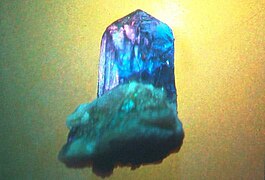
صورة ثلاثية الأبعاد للتنزانيت على ماتريكس
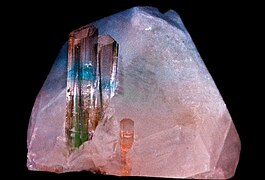
صورة ثلاثية الأبعاد من التورمالين على الكوارتز
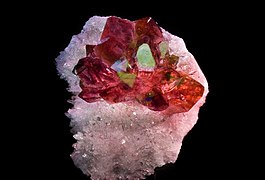
صورة ثلاثية الأبعاد من الجمشت على الكوارتز
وسائط التسجيل الثلاثية الأبعاد
يجب على وسيط التسجيل تحويل نمط التداخل الأصلي إلى عنصر بصري يعدل إما السعة أو ال مرحلة من شعاع الضوء الساقط بما يتناسب مع شدة مجال الضوء الأصلي.
يجب أن يكون وسيط التسجيل قادرًا على حل جميع الهوامش الناتجة عن التداخل بين الكائن والحزمة المرجعية. يمكن أن تتراوح هذه المسافات الهامشية من عشرات ميكرومتر إلى أقل من ميكرومتر واحد ، أي الترددات المكانية التي تتراوح من بضع مئات إلى عدة آلاف من الدورات / مم ، ومن الناحية المثالية ، يجب أن يكون لوسط التسجيل استجابة مسطحة فوق هذا النطاق. يحتوي فيلم التصوير الفوتوغرافي على استجابة منخفضة جدًا أو حتى صفرية عند الترددات المعنية ولا يمكن استخدامه لصنع صورة ثلاثية الأبعاد – على سبيل المثال ، دقة فيلم Kodak الاحترافي بالأبيض والأسود[34] يبدأ في السقوط عند 20 خطًا / مم – من غير المحتمل أن يتم الحصول على أي حزمة أعيد بناؤها باستخدام هذا الفيلم.
إذا لم تكن الاستجابة مسطحة على مدى الترددات المكانية في مخطط التداخل ، فقد تتدهور أيضًا دقة الصورة المعاد بناؤها.[35][36]
يوضح الجدول أدناه المواد الرئيسية المستخدمة في التسجيل الهولوغرافي. لاحظ أن هذه لا تشمل المواد المستخدمة في تكرار جماعي من صورة ثلاثية الأبعاد موجودة ، والتي تمت مناقشتها في القسم التالي. يشير حد الدقة الوارد في الجدول إلى الحد الأقصى لعدد خطوط التداخل / مم للشبكات. التعرض المطلوب ، معبراً عنه بالملليجول (mJ) من طاقة الفوتون التي تؤثر على مساحة السطح ، لفترة تعرض طويلة. أوقات التعرض القصيرة (أقل من1⁄1000 من الثانية ، كما هو الحال مع الليزر النبضي) تتطلب طاقات تعرض أعلى بكثير ، بسبب فشل المعاملة بالمثل.
| مواد | قابلة لإعادة الاستخدام | معالجة | نوع | الحد الأقصى النظري. كفاءة | التعريض المطلوب (mJ / cm2) | حد القرار (مم−1) |
|---|---|---|---|---|---|---|
| المستحلبات الفوتوغرافية | لا | مبلل | السعة | 6% | 1.5 | 5000 |
| المرحلة (ابيض) | 60% | |||||
| الجيلاتين ثنائي اللون | لا | مبلل | مرحلة | 100% | 100 | 10,000 |
| مقاومات الضوء | لا | مبلل | مرحلة | 30% | 100 | 3,000 |
| فوتثرموبلاستيك | نعم | الشحن والحرارة | مرحلة | 33% | 0.1 | 500–1,200 |
| فوتوبوليمرات | لا | التعرض اللاحق | مرحلة | 100% | 10000 | 5,000 |
| الانكسار الضوئي | نعم | لا شيء | مرحلة | 100% | 10 | 10,000 |
النسخ والإنتاج بالجملة
يمكن نسخ صورة ثلاثية الأبعاد موجودة بواسطة النقش[38] أو بصريا.[39]
تحتوي معظم التسجيلات الثلاثية الأبعاد (مثل هاليد الفضة المبيّض ، ومقاوم الضوء ، والبوليمرات الضوئية) على أنماط إغاثة سطحية تتوافق مع شدة الإضاءة الأصلية. يتضمن النقش ، الذي يشبه الطريقة المستخدمة لإخراج الأقراص البلاستيكية من الماجستير في التسجيل الصوتي ، نسخ نمط إغاثة السطح هذا عن طريق دمعه على مادة أخرى.
الخطوة الأولى في عملية النقش هي جعل الختام ترسيب كهربي من النيكل على صورة الإغاثة المسجلة على مقاوم الضوء أو اللدائن الضوئية. عندما تكون طبقة النيكل سميكة بدرجة كافية ، يتم فصلها عن الصورة العاكسة ثلاثية الأبعاد الرئيسية ويتم تثبيتها على لوح دعم معدني. تتكون المواد المستخدمة لعمل نسخ منقوشة من أ البوليستر الفيلم الأساسي وطبقة فصل الراتنج وأ لدن بالحرارة فيلم يشكل الطبقة الثلاثية الأبعاد.
يمكن إجراء عملية النقش بضغطة بسيطة ساخنة. يتم تسخين الطبقة السفلية من الفيلم المضاعف (طبقة اللدائن الحرارية) فوق نقطة التليين الخاصة بها ويتم ضغطها على الختم ، بحيث تأخذ شكلها. يتم الاحتفاظ بهذا الشكل عند تبريد الفيلم وإزالته من المكبس. من أجل السماح بمشاهدة الصور المجسمة المنقوشة في الانعكاس ، تتم عادةً إضافة طبقة عاكسة إضافية من الألومنيوم على طبقة تسجيل الهولوغرام. هذه الطريقة مناسبة بشكل خاص للإنتاج بالجملة.
كان الكتاب الأول الذي يحتوي على صورة ثلاثية الأبعاد على الغلاف الأمامي سكوك (وارنر بوكس ، 1984) بقلم جي بي ميلر، يعرض صورة توضيحية لميلر. كان أول غلاف ألبوم قياسي يحتوي على صورة ثلاثية الأبعاد هو “UB44″ ، تم إنتاجه في عام 1982 للمجموعة البريطانية UB40 بواسطة Advanced Holographics في لوبورو. This featured a 5.75” square embossed hologram showing a 3D image of the letters UB carved out of polystyrene to look like stone and the numbers 44 hovering in space on the picture plane. On the inner sleeve was an explanation of the holographic process and instructions on how to light the hologram. ناشيونال جيوغرافيك published the first magazine with a hologram cover in March 1984.[40] Embossed holograms are used widely on credit cards, banknotes, and high value products for authentication purposes.[41]
It is possible to print holograms directly into steel using a sheet explosive charge to create the required surface relief.[42] ال دار السك الكندية الملكية produces holographic gold and silver coinage through a complex stamping process.[43]
A hologram can be copied optically by illuminating it with a laser beam, and locating a second hologram plate so that it is illuminated both by the reconstructed object beam, and the illuminating beam. Stability and coherence requirements are significantly reduced if the two plates are located very close together.[44] ان فهرس matching fluid is often used between the plates to minimize spurious interference between the plates. Uniform illumination can be obtained by scanning point-by-point or with a beam shaped into a thin line.
Reconstructing and viewing the holographic image
When the hologram plate is illuminated by a laser beam identical to the reference beam which was used to record the hologram, an exact reconstruction of the original object wavefront is obtained. An imaging system (an eye or a camera) located in the reconstructed beam ‘sees’ exactly the same scene as it would have done when viewing the original. When the lens is moved, the image changes in the same way as it would have done when the object was in place. If several objects were present when the hologram was recorded, the reconstructed objects move relative to one another, i.e. exhibit المنظر, in the same way as the original objects would have done. It was very common in the early days of holography to use a chess board as the object and then take photographs at several different angles using the reconstructed light to show how the relative positions of the chess pieces appeared to change.
A holographic image can also be obtained using a different laser beam configuration to the original recording object beam, but the reconstructed image will not match the original exactly.[45] When a laser is used to reconstruct the hologram, the image is speckled just as the original image will have been. This can be a major drawback in viewing a hologram.
White light consists of light of a wide range of wavelengths. Normally, if a hologram is illuminated by a white light source, each wavelength can be considered to generate its own holographic reconstruction, and these will vary in size, angle, and distance. These will be superimposed, and the summed image will wipe out any information about the original scene, as if superimposing a set of photographs of the same object of different sizes and orientations. However, a holographic image can be obtained using white light in specific circumstances, e.g. with volume holograms and rainbow holograms. The white light source used to view these holograms should always approximate to a point source, i.e. a spot light or the sun. An extended source (e.g. a fluorescent lamp) will not reconstruct a hologram since its light is incident at each point at a wide range of angles, giving multiple reconstructions which will “wipe” one another out.
White light reconstructions do not contain speckles.
Volume holograms
المقال الرئيسي: Volume hologram
A reflection-type volume hologram can give an acceptably clear reconstructed image using a white light source, as the hologram structure itself effectively filters out light of wavelengths outside a relatively narrow range. In theory, the result should be an image of approximately the same colour as the laser light used to make the hologram. In practice, with recording media that require chemical processing, there is typically a compaction of the structure due to the processing and a consequent colour shift to a shorter wavelength. Such a hologram recorded in a silver halide gelatin emulsion by red laser light will usually display a green image. Deliberate temporary alteration of the emulsion thickness before exposure, or permanent alteration after processing, has been used by artists to produce unusual colours and multicoloured effects.
Rainbow holograms
In this method, parallax in the vertical plane is sacrificed to allow a bright, well-defined, gradiently colored reconstructed image to be obtained using white light. The rainbow holography recording process usually begins with a standard transmission hologram and copies it using a horizontal slit to eliminate vertical المنظر in the output image. The viewer is therefore effectively viewing the holographic image through a narrow horizontal slit, but the slit has been expanded into a window by the same تشتت that would otherwise smear the entire image. Horizontal parallax information is preserved but movement in the vertical direction results in a color shift rather than altered vertical perspective.[46] Because perspective effects are reproduced along one axis only, the subject will appear variously stretched or squashed when the hologram is not viewed at an optimum distance; this distortion may go unnoticed when there is not much depth, but can be severe when the distance of the subject from the plane of the hologram is very substantial. ستيروبس and horizontal motion parallax, two relatively powerful cues to depth, are preserved.
The holograms found on بطاقات الائتمان are examples of rainbow holograms. These are technically transmission holograms mounted onto a reflective surface like a metalized polyethylene terephthalate substrate commonly known as حيوان اليف.

Rainbow hologram showing the change in colour in the vertical direction
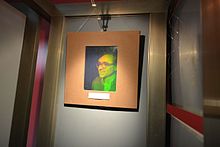
Holographic self-portrait, exhibited at the National Polytechnic Museum, Sofia

يتم استخدام جدول بصري لعمل صورة ثلاثية الأبعاد

لوحة المنطقة الجيبية

هذه صورة لجزء صغير من صورة ثلاثية الأبعاد غير مبيضة للإرسال يتم عرضها من خلال مجهر. سجلت الصورة الثلاثية الأبعاد صورًا لسيارة شاحنة وسيارة. لم يعد من الممكن تمييز موضوع الصورة المجسمة من هذا النمط أكثر من تحديد الموسيقى التي تم تسجيلها من خلال النظر إلى قرص مضغوط سطح – المظهر الخارجي. يتم تسجيل المعلومات الثلاثية الأبعاد بواسطة نمط البقع
Fidelity of the reconstructed beam
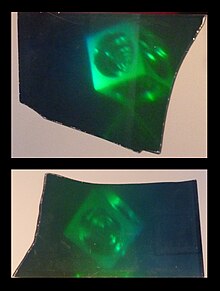
Reconstructions from two parts of a broken hologram. Note the different viewpoints required to see the whole
object
To replicate the original object beam exactly, the reconstructing reference beam must be identical to the original reference beam and the recording medium must be able to fully resolve the interference pattern formed between the object and reference beams.[47] Exact reconstruction is required in قياس التداخل المجسم, where the holographically reconstructed wavefront يتدخل with the wavefront coming from the actual object, giving a null fringe if there has been no movement of the object and mapping out the displacement if the object has moved. This requires very precise relocation of the developed holographic plate.
Any change in the shape, orientation or wavelength of the reference beam gives rise to aberrations in the reconstructed image. For instance, the reconstructed image is magnified if the laser used to reconstruct the hologram has a longer wavelength than the original laser. Nonetheless, good reconstruction is obtained using a laser of a different wavelength, quasi-monochromatic light or white light, in the right circumstances.
Since each point in the object illuminates all of the hologram, the whole object can be reconstructed from a small part of the hologram. Thus, a hologram can be broken up into small pieces and each one will enable the whole of the original object to be imaged. One does, however, lose information and the الدقة المكاني gets worse as the size of the hologram is decreased – the image becomes “fuzzier”. The field of view is also reduced, and the viewer will have to change position to see different parts of the scene.
التطبيقات
فن
Early on, artists saw the potential of holography as a medium and gained access to science laboratories to create their work. Holographic art is often the result of collaborations between scientists and artists, although some holographers would regard themselves as both an artist and a scientist.
سلفادور دالي claimed to have been the first to employ holography artistically. He was certainly the first and best-known surrealist to do so, but the 1972 New York exhibit of Dalí holograms had been preceded by the holographic art exhibition that was held at the أكاديمية كرانبروك للفنون in Michigan in 1968 and by the one at the Finch College gallery in New York in 1970, which attracted national media attention.[48] In Great Britain, Margaret Benyon began using holography as an artistic medium in the late 1960s and had a solo exhibition at the جامعة نوتنجهام art gallery in 1969.[49] This was followed in 1970 by a solo show at the معرض ليسون in London, which was billed as the “first London expo of holograms and stereoscopic paintings”.[50]
During the 1970s, a number of art studios and schools were established, each with their particular approach to holography. Notably, there was the San Francisco School of Holography established by Lloyd Cross, The Museum of Holography in New York founded by Rosemary (Posy) H. Jackson, the Royal College of Art in London and the كلية ليك فورست Symposiums organised by Tung Jeong.[51] None of these studios still exist; however, there is the Center for the Holographic Arts in New York[52] and the HOLOcenter in Seoul, which offers artists a place to create and exhibit work.
During the 1980s, many artists who worked with holography helped the diffusion of this so-called “new medium” in the art world, such as Harriet Casdin-Silver of the United States, Dieter Jung of Germany, and Moysés Baumstein من البرازيل, each one searching for a proper “language” to use with the three-dimensional work, avoiding the simple holographic reproduction of a sculpture or object. For instance, in Brazil, many concrete poets (Augusto de Campos, Décio Pignatari, Julio Plaza and José Wagner Garcia, associated with Moysés Baumstein) found in holography a way to express themselves and to renew Concrete Poetry.
A small but active group of artists still integrate holographic elements into their work.[53] Some are associated with novel holographic techniques; for example, artist Matt Brand[54] employed computational mirror design to eliminate image distortion from specular holography.
The MIT Museum[55] and Jonathan Ross[56] both have extensive collections of holography and on-line catalogues of art holograms.
مخزن البيانات
المقال الرئيسي: Holographic memory
Holography can be put to a variety of uses other than recording images. تخزين البيانات الثلاثية الأبعاد is a technique that can store information at high density inside crystals or photopolymers. The ability to store large amounts of information in some kind of medium is of great importance, as many electronic products incorporate storage devices. As current storage techniques such as قرص الشعاع الازرق reach the limit of possible data density (due to the الانحراف-limited size of the writing beams), holographic storage has the potential to become the next generation of popular storage media. The advantage of this type of data storage is that the volume of the recording media is used instead of just the surface.Currently available SLMs can produce about 1000 different images a second at 1024×1024-bit resolution. With the right type of medium (probably polymers rather than something like LiNbO3), this would result in about one-gigabit-per-second writing speed.[بحاجة لمصدر] Read speeds can surpass this, and experts[منظمة الصحة العالمية؟] believe one-terabit-per-second readout is possible.
In 2005, companies such as Optware و ماكسيل produced a 120mm disc that uses a holographic layer to store data to a potential 3.9السل, a format called قرص ثلاثي الأبعاد متعدد الاستخدامات. As of September 2014, no commercial product has been released.
Another company, InPhase Technologies, was developing a competing format, but went bankrupt in 2011 and all its assets were sold to Akonia Holographics, LLC.
While many holographic data storage models have used “page-based” storage, where each recorded hologram holds a large amount of data, more recent research into using submicrometre-sized “microholograms” has resulted in several potential تخزين البيانات الضوئية ثلاثية الأبعاد حلول. While this approach to data storage can not attain the high data rates of page-based storage, the tolerances, technological hurdles, and cost of producing a commercial product are significantly lower.
Dynamic holography
In static holography, recording, developing and reconstructing occur sequentially, and a permanent hologram is produced.
There also exist holographic materials that do not need the developing process and can record a hologram in a very short time. This allows one to use holography to perform some simple operations in an all-optical way. Examples of applications of such real-time holograms include phase-conjugate mirrors (“time-reversal” of light), optical cache memories, معالجة الصورة (pattern recognition of time-varying images), and optical computing.
The amount of processed information can be very high (terabits/s), since the operation is performed in parallel on a whole image. This compensates for the fact that the recording time, which is in the order of a microsecond, is still very long compared to the processing time of an electronic computer. The optical processing performed by a dynamic hologram is also much less flexible than electronic processing. On one side, one has to perform the operation always on the whole image, and on the other side, the operation a hologram can perform is basically either a multiplication or a phase conjugation. In optics, addition and تحويل فورييه are already easily performed in linear materials, the latter simply by a lens. This enables some applications, such as a device that compares images in an optical way.[57]
The search for novel nonlinear optical materials for dynamic holography is an active area of research. The most common materials are photorefractive crystals, but in أشباه الموصلات أو semiconductor heterostructures (مثل quantum wells), atomic vapors and gases, البلازما and even liquids, it was possible to generate holograms.
A particularly promising application is optical phase conjugation. It allows the removal of the wavefront distortions a light beam receives when passing through an aberrating medium, by sending it back through the same aberrating medium with a conjugated phase. This is useful, for example, in free-space optical communications to compensate for atmospheric turbulence (the phenomenon that gives rise to the twinkling of starlight).
Hobbyist use
Since the beginning of holography, amateur experimenters have explored its uses.
في عام 1971 ، Lloyd Cross opened the San Francisco School of Holography and taught amateurs how to make holograms using only a small (typically 5 mW) helium-neon laser and inexpensive home-made equipment. Holography had been supposed to require a very expensive metal optical table set-up to lock all the involved elements down in place and damp any vibrations that could blur the interference fringes and ruin the hologram. Cross’s home-brew alternative was a صندوق الرمل made of a كتلة جمرة retaining wall on a plywood base, supported on stacks of old tires to isolate it from ground vibrations, and filled with sand that had been washed to remove dust. The laser was securely mounted atop the cinder block wall. The mirrors and simple lenses needed for directing, splitting and expanding the laser beam were affixed to short lengths of PVC pipe, which were stuck into the sand at the desired locations. The subject and the لوحة فوتوغرافية holder were similarly supported within the sandbox. The holographer turned off the room light, blocked the laser beam near its source using a small تناوب-controlled shutter, loaded a plate into the holder in the dark, left the room, waited a few minutes to let everything settle, then made the exposure by remotely operating the laser shutter.
Many of these holographers would go on to produce art holograms. In 1983, Fred Unterseher, a co-founder of the San Francisco School of Holography and a well-known holographic artist, published the Holography Handbook, an easy-to-read guide to making holograms at home. This brought in a new wave of holographers and provided simple methods for using the then-available AGFA هاليد الفضة recording materials.
في 2000، Frank DeFreitas نشر Shoebox Holography Book and introduced the use of inexpensive مؤشرات الليزر to countless هواة. For many years, it had been assumed that certain characteristics of semiconductor laser diodes made them virtually useless for creating holograms, but when they were eventually put to the test of practical experiment, it was found that not only was this untrue, but that some actually provided a coherence length much greater than that of traditional helium-neon gas lasers. This was a very important development for amateurs, as the price of red laser diodes had dropped from hundreds of dollars in the early 1980s to about $5 after they entered the mass market as a component of DVD players in the late 1990s. Now, there are thousands of amateur holographers worldwide.
By late 2000, holography kits with inexpensive laser pointer diodes entered the mainstream consumer market. These kits enabled students, teachers, and hobbyists to make several kinds of holograms without specialized equipment, and became popular gift items by 2005.[58] The introduction of holography kits with self-developing لوحات in 2003 made it possible for hobbyists to create holograms without the bother of wet chemical processing.[59]
In 2006, a large number of surplus holography-quality green lasers (Coherent C315) became available and put dichromated gelatin (DCG) holography within the reach of the amateur holographer. The holography community was surprised at the amazing sensitivity of DCG to green ضوء. It had been assumed that this sensitivity would be uselessly slight or non-existent. Jeff Blyth responded with the G307 formulation of DCG to increase the speed and sensitivity to these new lasers.[60]
Kodak and Agfa, the former major suppliers of holography-quality silver halide plates and films, are no longer in the market. While other manufacturers have helped fill the void, many amateurs are now making their own materials. The favorite formulations are dichromated gelatin, Methylene-Blue-sensitised dichromated gelatin, and diffusion method silver halide preparations. Jeff Blyth has published very accurate methods for making these in a small lab or garage.[61]
A small group of amateurs are even constructing their own pulsed lasers to make holograms of living subjects and other unsteady or moving objects.[62]
قياس التداخل المجسم
المقال الرئيسي: قياس التداخل المجسم
Holographic interferometry (HI) is a technique that enables static and dynamic displacements of objects with optically rough surfaces to be measured to optical interferometric precision (i.e. to fractions of a wavelength of light).[63][64] It can also be used to detect optical-path-length variations in transparent media, which enables, for example, fluid flow to be visualized and analyzed. It can also be used to generate contours representing the form of the surface or the isodose regions in radiation dosimetry.[65]
It has been widely used to measure stress, strain, and vibration in engineering structures.
Interferometric microscopy
المقال الرئيسي: Interferometric microscopy
The hologram keeps the information on the amplitude and phase of the field. Several holograms may keep information about the same distribution of light, emitted to various directions. The numerical analysis of such holograms allows one to emulate large فتحة عددية, which, in turn, enables enhancement of the resolution of optical microscopy. The corresponding technique is called interferometric microscopy. Recent achievements of interferometric microscopy allow one to approach the quarter-wavelength limit of resolution.[66]
Sensors or biosensors
المقال الرئيسي: Holographic sensor
The hologram is made with a modified material that interacts with certain molecules generating a change in the fringe periodicity or refractive index, therefore, the color of the holographic reflection.[67][68]
الأمان:
Security holograms are very difficult to forge, because they are replicated from a master hologram that requires expensive, specialized and technologically advanced equipment. They are used widely in many العملات، مثل ال برازيلي 20, 50, and 100-reais notes; بريطاني 5, 10, and 20-pound notes; كوريا الجنوبية 5000, 10,000, and 50,000-won notes; اليابانية 5000 and 10,000 yen notes, هندي 50,100,500, and 2000 rupee notes; and all the currently-circulating banknotes of the الدولار الكندي, كونا كرواتية, كرونة دنماركيةو و اليورو. They can also be found in credit and bank cards as well as جوازات السفر, ID cards, الكتب, أقراص DVDو و معدات رياضية.
تطبيقات أخرى
Holographic scanners are in use in post offices, larger shipping firms, and automated conveyor systems to determine the three-dimensional size of a package. They are often used in tandem with أجهزة تدقيق الوزن to allow automated pre-packing of given volumes, such as a truck or pallet for bulk shipment of goods.Holograms produced in elastomers can be used as stress-strain reporters due to its elasticity and compressibility, the pressure and force applied are correlated to the reflected wavelength, therefore its color.[69] Holography technique can also be effectively used for radiation dosimetry.[70][71]
سلع استهلاكية صناعة
These are the hologram adhesive strips that provide protection against counterfeiting and duplication of products. These protective strips can be used on FMCG products like cards, medicines, food, audio-visual products etc. Hologram protection strips can be directly laminated on the product covering.
Electrical and electronic products
Hologram tags have an excellent ability to inspect an identical product. These kind of tags are more often used for protecting duplication of electrical and electronic products. These tags are available in a variety colors, sizes and shapes.
Hologram dockets for vehicle number plate
Some vehicle number plates on bikes or cars have registered hologram stickers which indicate authenticity. For the purpose of identification they have unique ID numbers.
High security holograms for credit cards
These are holograms with high security features like micro texts, nano texts, complex images, logos and a multitude of other features. Holograms once affixed on Debit cards/passports cannot be removed easily. They offer an individual identity to a brand along with its protection.
Non-optical
In principle, it is possible to make a hologram for any موجة.
Electron holography is the application of holography techniques to electron waves rather than light waves. Electron holography was invented by Dennis Gabor to improve the resolution and avoid the aberrations of the انتقال المجهر الإلكتروني. Today it is commonly used to study electric and magnetic fields in thin films, as magnetic and electric fields can shift the phase of the interfering wave passing through the sample.[72] The principle of electron holography can also be applied to interference lithography.[73]
Acoustic holography is a method used to estimate the sound field near a source by measuring acoustic parameters away from the source via an array of pressure and/or particle velocity transducers. Measuring techniques included within acoustic holography are becoming increasingly popular in various fields, most notably those of transportation, vehicle and aircraft design, and NVH. The general idea of acoustic holography has led to different versions such as near-field acoustic holography (NAH) and statistically optimal near-field acoustic holography (SONAH). For audio rendition, the wave field synthesis is the most related procedure.
Atomic holography has evolved out of the development of the basic elements of atom optics. With the Fresnel diffraction lens and atomic mirrors atomic holography follows a natural step in the development of the physics (and applications) of atomic beams. Recent developments including atomic mirrors وخاصة ridged mirrors have provided the tools necessary for the creation of atomic holograms,[74] although such holograms have not yet been commercialized.
نيوترون beam holography has been used to see the inside of solid objects.[75]
False holograms
Effects produced by lenticular printing، ال Pepper’s ghost illusion (or modern variants such as the Musion Eyeliner), الأشعة المقطعية و volumetric displays are often confused with holograms.[76][77] Such illusions have been called “fauxlography”
The Pepper’s ghost technique, being the easiest to implement of these methods, is most prevalent in 3D displays that claim to be (or are referred to as) “holographic”. While the original illusion, used in theater, involved actual physical objects and persons, located offstage, modern variants replace the source object with a digital screen, which displays imagery generated with رسومات حاسوبية ثلاثية الأبعاد to provide the necessary depth cues. The reflection, which seems to float mid-air, is still flat, however, thus less realistic than if an actual 3D object was being reflected.
Examples of this digital version of Pepper’s ghost illusion include the غوريلاز performances in the 2005 MTV Europe Music Awards و ال جوائز جرامي ال 48؛ و توباك شاكور‘s virtual performance at مهرجان وادي كوتشيلا للموسيقى والفنون in 2012, rapping alongside سنوب دوج during his set with الدكتور دري.[80]
An even simpler illusion can be created by rear-projecting realistic images into semi-transparent screens. The rear projection is necessary because otherwise the semi-transparency of the screen would allow the background to be illuminated by the projection, which would break the illusion.
كريبتون فيوتشر ميديا, a music software company that produced هاتسون ميكو,[81] one of many فوكالويد singing synthesizer applications, has produced concerts that have Miku, along with other Crypton Vocaloids, performing on stage as “holographic” characters. These concerts use rear projection onto a semi-transparent DILAD screen[82][83] to achieve its “holographic” effect.[84][85]
In 2011, in Beijing, apparel company بربري produced the “Burberry Prorsum Autumn/Winter 2011 Hologram Runway Show”, which included life size 2-D projections of models. The company’s own video[86] shows several centered and off-center shots of the main 2-dimensional projection screen, the latter revealing the flatness of the virtual models. The claim that holography was used was reported as fact in the trade media.[87]
في مدريد, on 10 April 2015, a public visual presentation called “Hologramas por la Libertad” (Holograms for Liberty), featuring a ghostly virtual crowd of demonstrators, was used to protest a new Spanish law that prohibits citizens from demonstrating in public places. Although widely called a “hologram protest” in news reports,[88] no actual holography was involved – it was yet another technologically updated variant of the Pepper’s Ghost وهم.
في الخيال
Holography has been widely referred to in movies, novels, and TV, usually in الخيال العلمي, starting in the late 1970s.[89] Science fiction writers absorbed the urban legends surrounding holography that had been spread by overly-enthusiastic scientists and entrepreneurs trying to market the idea.[89] This had the effect of giving the public overly high expectations of the capability of holography, due to the unrealistic depictions of it in most fiction, where they are fully three-dimensional computer projections that are sometimes tactile through the use of حقول القوة.[89] Examples of this type of depiction include the hologram of الأميرة ليا في حرب النجوم, Arnold Rimmer من عند القزم الأحمر, who was later converted to “hard light” to make him solid, and the هولوديك و Emergency Medical Hologram من عند ستار تريك.[89]
Holography served as an inspiration for many video games with the science fiction elements. In many titles, fictional holographic technology has been used to reflect real life misrepresentations of potential military use of holograms, such as the “mirage tanks” in القيادة والقهر: الإنذار الأحمر 2 that can disguise themselves as trees.[90] شخصيات اللاعب are able to use holographic decoys in games such as Halo: Reach و كرايسس 2 to confuse and distract the enemy.[90] ستاركرافت ghost agent Nova has access to “holo decoy” as one of her three primary abilities in أبطال العاصفة.[91]
Fictional depictions of holograms have, however, inspired technological advances in other fields, such as الواقع المعزز, that promise to fulfill the fictional depictions of holograms by other means.[92]

Pepper’s ghost with a 2D video. The video image displayed on the floor is reflected in an angled sheet of glass.

Holograms on credit cards.
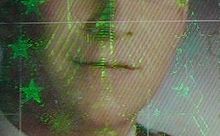
Identigram as a security element in a German identity card

Peace Within Reach, a Denisyuk DCG hologram by amateur Dave Battin
3D file formats
التصوير المجسم الناتج عن الكمبيوتر
عرض ثلاثي الأبعاد
الواقع المعزز
Australian Holographics
التنظير الذاتي
Digital holography
Digital holographic microscopy
Digital planar holography
شاشة الضباب
مبدأ التصوير المجسم
Holonomic brain theory
Hogel Processing Unit
التصوير المتكامل
قائمة التقنيات الناشئة
Phase-coherent holography
Plasmon – Possible applications (Full Color Holography)
الأشعة المقطعية
العرض الحجمي
Volumetric printing

